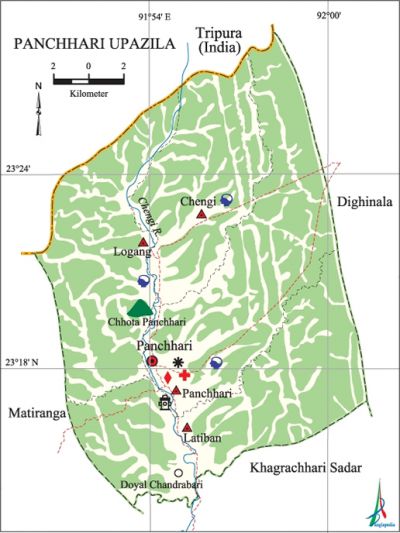Panchhari Upazila
Panchhari Upazila (khagrachhari district) area 334.10 sq km, located in between 23°12' and 23°28' north latitudes and in between 91°50' and 92°00' east longitudes. It is bounded by tripura state of India on the north, khagrachhari sadar upazila on the south, dighinala upazila on the east, matiranga upazila on the west.
Population Total 62198; male 31352, female 30846; Muslim 18816, Hindu 12364, Buddhist 30294, Christian 286 and others 438. Indigenous communities such as chakma, tripura and marma. belong to this upazila.
Water bodies Main river: Chengi.
Administration Panchhari Thana was formed on 1 October 1976 and it was turned into an upazila in 1984.
| Upazila | ||||||||
| Municipality | Union | Mouza | Village | Population | Density (per sq km) | Literacy rate (%) | ||
| Urban | Rural | Urban | Rural | |||||
| - | 5 | 7 | 220 | 22706 | 39492 | 186 | 49.6 | 38.0 |
| Upazila Town | ||||||||
|
Area (sq km) |
Mouza |
Population |
Density (per sq km) |
Literacy rate (%) | ||||
| 82.88 | 1 | 22706 | 274 | 49.6 | ||||
| Union | ||||
| Name of union and GO code | Area (acre) | Population | Literacy rate (%) | |
| Male | Female | |||
| Ulta Chari 89 | 10240 | 5710 | 5770 | 37.2 |
| Chengi 19 | 14720 | 4037 | 3992 | 37.1 |
| Panchhari 76 | 20480 | 11527 | 11179 | 49.6 |
| Latiban 38 | 27520 | 4241 | 4108 | 36.9 |
| Logang 57 | 19840 | 5837 | 5797 | 40.2 |
Source Bangladesh Population Census 2011, Bangladesh Bureau of Statistics.

Historical events In June 1986, the members of the shanti bahini' of the Chittagong Hill Tracts killed 105 persons of Damdam, Kalanal and Chhantila areas of the upazila. On 5 March 1998 the armed cadres of the Shanti Bahini surrendered their arms and ammunitions at Dudukchhara under Logang union as per the chittagong hill tracts peace accord, 1997. In this place, on this day, the Shanti Bahini was declared to be abolished.
War of Liberation The first group of freedom fighters receiving formal arms training had got the training locally at Ompinagar of Tellemura and later, they went to Shilachhari camp of India for higher training. Many local freedom fighters joined with them and they formed a total of five companies to carry out operations in the upazila and adjacent localities. One of the notable operations was the attack on Pakistani soldiers at Pancchari camp.
For details: see পানছড়ি উপজেলা, বাংলাদেশ মুক্তিযুদ্ধ জ্ঞানকোষ (Encyclopedia of Bangladesh War of Liberation), বাংলাদেশ এশিয়াটিক সোসাইটি, ঢাকা ২০২০, খণ্ড ৫।
Literacy rate and educational institutions Average literacy 42.3%; male 48.7%, female 35.7%. Noted educational institutions: Panchhari College (1990), Panchhari High School and College (1981).
Cultural organisations Club 17, theatre group 1, cinema hall 1, playground 7.
Main sources of income Agriculture 64.84%, non-agricultural labourer 9.56%, industry 0.27%, commerce 8.56%, transport and communication 0.74%, service 5.86%, construction 0.57%, religious service 0.22%, rent and remittance 0.32% and others 9.06%.
Ownership of agricultural land Landowner 42.46%, landless 57.54%; agricultural landowner: urban 38.76% and rural 44.49%.'
Main crops Paddy, wheat, potato, maize, mustard, sesame, ginger, turmeric, vegetables, bamboo.
Main fruits Mango, jackfruit, litchi, banana, papaya, pineapple, sugarcane.
Fisheries, dairies and poultries Poultry 3.
Communication facilities Roads: pucca 43 km, semi-pucca 48 km, mud road 269 km.
Extinct or nearly extinct traditional transport Bullock cart.
Noted manufactories Ice factory.
Cottage industries Goldsmith, blacksmith, potteries, weaving, bamboo work.
Hats, bazars and fairs Hats and bazars are 3, fair 1, most noted of which are Logang Bazar, Puijagang Bazar, Ultachhari Bazar and Bijay Mela at Panchhari Sadar.
Main exports Wood, bamboo, ginger, turmeric, sesame, mustard, banana, jackfruit, pineapple.
Access to electricity All the unions of the upazila are under rural electrification net-work. However 28.8% of the dwelling households have access to electricity.
Sources of drinking water Tube-well 69.8%, tap 0.7% and others 29.5%.
Sanitation 15.3% of dwelling households of the upazila use sanitary latrines and 78.2% of dwelling households use non-sanitary latrines; 6.5% of households do not have latrine facilities.
Health centres Upazila health complex 1, family planning centre 3, diagnostic centre 3.
NGO activities Operationally important NGOs are brac, UNICEF. [Sanjay Kishore Das]
References Bangladesh Population Census 2001 and 2011, Bangladesh Bureau of Statistics; Cultural survey report of Panchhari Upazila 2007.
